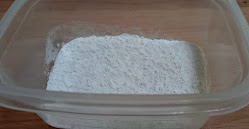You would have come across these in Dim Sum Restaurants. Peanut mochi is a popular Asian party food and a delightful sweet treat for your family and friends. Made of glutinous rice flour, it has a sticky, soft and chewy texture. Stuffed with crunchy roasted peanut and sugar, they become irresistible morsels of bliss. I learned to make them at a cooking class held at the Hillview Intercultural Community Centre in a suburb of Perth which hosts a range of support services for migrant families. Unlike traditional recipes, the dough is boiled in water, not steamed, which is easier and quicker to do. The trickiest part is the wrapping of the filling in the mochi to form nice little balls. It takes some practice so don't stress. I am including a short video of how my teacher does it expertly here as a reference. They don't need to be perfectly shaped to be delicious, and after you've done your first one, it can go straight into your mouth (say for quality control). I hope the photographs below help to illustrate the process and convince you how fun it is to try and make them.
Makes 16
INGREDIENTS
- 1 cup rice flour, for coating
- 250g / 9oz glutinous rice flour
- 3 tablespoons wheat starch
- 1 cup water
- 150g / 5½oz roasted unsalted peanuts
- 3 tablespoons caster sugar
- 2 tablespoons maple syrup
- 2 tablespoons vegetable oil, for oiling the work surface and your hands
METHOD
- Cook the rice flour by toasting it in a dry, medium-size frying pan over medium heat for 8-10 minutes, stirring occasionally. Set aside to cool in a container.
- Pulse peanuts several times in a food processor until finely chopped. Stir in sugar and maple syrup (which helps it to bind). Set aside.
- In a large mixing bowl, combine glutinous rice flour and wheat starch. Add water and stir with a rubber spatula until a dough begins to form. With clean hands, shape the dough into a smooth ball.
- Transfer the dough to a work surface lined with a silicone pastry mat (which prevents the dough from sticking to the surface). With a plastic bowl scraper, divide the dough up into 10 equal portions. Shape each portion into a thick round disc.
- Cook the discs in a large pot of rapidly boiling water for about 5 minutes or until the discs float to the top. Transfer the cooked discs back to the mixing bowl using a wire skimmer or slotted spoon.
- With a wooden rolling pin, pound the discs gently in the bowl for 8-10 minutes or until they come together in form of a sticky white mass.
- When the sticky mass has cooled down sufficiently to be handled, oil the work surface and the palm of your hands. With the help of a bowl scraper, turn the sticky mass onto the work surface and knead it for a few minutes into a smooth, stretchy dough.
- Divide the dough into two halves. Cover one half with plastic wrap to keep it from drying up while you work on the other half.
- With the bowl scraper, divide the first dough into 8 equal portions.
- Coat each portion of the dough in the cooked rice flour prepared earlier. With your hands, flatten each piece of dough into a disc about 6.5cm / 2.5" in diameter. Fill each disc with 1 tablespoon of the peanut mixture. Gather the edge towards the centre and pinch firmly to seal. Roll the dough in between palms to smooth it into a nice round ball.
- Coat the mochi ball with cooked rice flour. Dust off any excess and place it in a small cup cake liner to serve.
- Repeat steps 9 to 11 with the second dough to make 16 mochi balls all up.
TIPS:
- Mochi are best eaten as soon as they have been made. Store them in an airtight container for no more than 24 hours in room temperature. If you store them in the fridge, they will soon begin to dry out. In such case, you can rejuvenate them by heating the mochi for a few seconds in the microwave oven.
- You will find the mochi dough rather sticky to handle. The silicone pastry mat helps a lot by providing a non-stick work surface. The dough is also less inclined to stick to plastic as opposed to wooden utensils. Some people prefer to use disposable food grade gloves from start to finish. When things get sticky, I coat my hands with extra oil or dip my fingertips in a dish of warm water.
















No comments:
Post a Comment